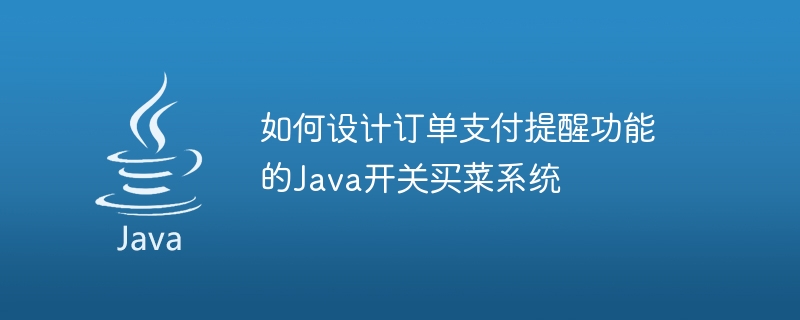Home >Java >javaTutorial >How to design a Java switch grocery shopping system with order payment reminder function
How to design a Java switch grocery shopping system with order payment reminder function
- 王林Original
- 2023-11-01 13:33:241523browse

How to design a Java switch grocery shopping system with order payment reminder function
With the rapid development of e-commerce, people increasingly prefer to purchase daily necessities through the Internet. Including food and daily necessities. The question that arises is, how to ensure on-time payment of orders? In the Java switch grocery shopping system, we can design an order payment reminder function so that users will not miss the best time to pay the order.
First, we need to set an order payment deadline in the system. After the user places an order, the system will calculate the countdown time based on the order deadline, and add it to a message queue after the user places the order successfully.
Secondly, we can use Java's scheduled task scheduler, such as the Quartz framework, to monitor messages in the message queue. Every once in a while, the task scheduler will automatically execute a task to check the orders that have reached the payment deadline.
In the process of the task scheduler executing the task, we need to judge the payment status of the order. If the order has not been paid, a payment reminder message is sent to the user and the number of reminders is recorded. If the order has been paid, remove the message from the message queue.
At the same time, we can also set a maximum number of reminders. If an order is not paid within the specified number of reminders, the system can mark the order as a timeout order and take corresponding measures, such as canceling the order or deducting certain credit points.
In addition, in order to improve user experience, we can send payment reminder messages to users through various methods such as email, SMS or push notifications. Users can choose their preferred method within the system.
In order to protect user privacy, we also need to encrypt and securely transmit payment reminder messages. In system design, we can use SSL/TLS protocol to establish a secure communication channel, and use encryption algorithms to encrypt and decrypt message content.
In addition to the order payment reminder function, we can also introduce other auxiliary functions into the Java switch grocery shopping system, such as payment countdown, diversified payment methods, order refunds and after-sales services, etc. The introduction of these functions can improve users' shopping experience and promote users' repurchase and word-of-mouth spread.
To sum up, when designing a Java switch grocery shopping system, the order payment reminder function is an essential part. By setting the order payment deadline, using a scheduled task scheduler, and sending payment reminder messages, we can ensure timely payment of orders and improve user shopping convenience and satisfaction.
Of course, in actual development, we also need to consider issues such as system stability, fault tolerance, and performance optimization. Through reasonable system design and efficient programming implementation, we can create a stable and reliable Java switch grocery shopping system to provide users with a better shopping experience.
The above is the detailed content of How to design a Java switch grocery shopping system with order payment reminder function. For more information, please follow other related articles on the PHP Chinese website!

